Kuopio
Kuopio (Finnish pronunciation: [ˈkuo̯pio]) is a Finnish city and municipality located in the region of Northern Savonia (Pohjois-Savo). It has a population of 118,667,[2] which makes it the ninth-most populous city in Finland and the most populous city in Eastern Finland Province.[6] Kuopio has a total area of 4,326.35 square kilometres (1,670.41 sq mi), of which 719.85 km2 (277.94 sq mi) is water[1] and half is forest. Though the city's population is a spread-out 74/km2 (190/sq mi), the city's urban areas are populated comparably densely (urban area: 1,618 /km²),[7] making Kuopio Finland's second-most densely populated city.
Kuopio | |
|---|---|
City | |
| Kuopion kaupunkiKuopio stad | |
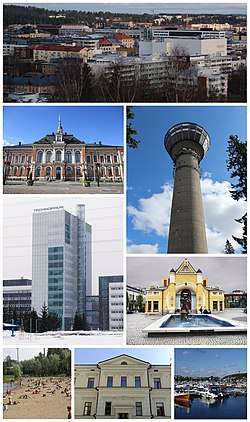 Clockwise from top-left: the cityscape of the center, the Puijo Tower, the Kuopio Market Hall, the Kuopio Marina, the Govenor Palace, the Väinölänniemi Beach, the Technopolis Microtower (part of the Technology Centre Teknia), and the Kuopio City Hall. | |
 Coat of arms | |
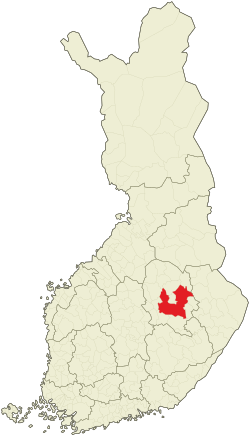 | |
| Coordinates: 62°53′33″N 27°40′42″E | |
| Country | |
| Region | |
| Sub-region | Kuopio sub-region |
| Settled | 1653 |
| Charter | 1775 |
| Government | |
| • City manager | Jarmo Pirhonen |
| Area (2018-01-01)[1] | |
| • Total | 4,326.35 km2 (1,670.41 sq mi) |
| • Land | 1,597.39 km2 (616.76 sq mi) |
| • Water | 719.85 km2 (277.94 sq mi) |
| Area rank | 18th largest in Finland |
| Population (2019-01-31)[2] | |
| • Total | 118,667 |
| • Rank | 9th largest in Finland |
| • Density | 74.29/km2 (192.4/sq mi) |
| Population by native language | |
| • Finnish | 97.8% (official) |
| • Swedish | 0.1% |
| • Others | 2.1% |
| Population by age | |
| • 0 to 14 | 15.6% |
| • 15 to 64 | 68.9% |
| • 65 or older | 15.4% |
| Time zone | UTC+02:00 (EET) |
| • Summer (DST) | UTC+03:00 (EEST) |
| Postal code | FI-70101 |
| Municipal tax rate[5] | 19.5% |
| Website | kuopio.fi |
Kuopio is known nationwide as one of the most important study cities and centers of attraction and growth,[8][6][9] but on the other hand, the history of Kuopio has been characterized by several municipality mergers since 1969, as a result of which Kuopio now includes many countryside; Kuopio's population surpassed 100,000 when the town of Nilsiä joined the city at the beginning of 2013, and when Maaninka joined Kuopio at the beginning of 2015, Kuopio became Finland's largest milk producer community and Finland's second largest beef producer community. In addition, at the end of the 2010s, Kuopio was marked by numerous large projects, which are the largest in the city nationwide immediately after the Helsinki's metropolitan area.[10] With the large tourist center in Tahkovuori, Kuopio has also grown into a major tourist city. Kuopio Airport, located in the Siilinjärvi municipality that almost surrounded by Kuopio, is Finland's fifth-busiest airport, with over 235,000 passengers in 2017.[11]
According to Kuntarating 2017 survey, Kuopio has the most satisfied residents among the 20 largest cities,[12] and according to the 2018 survey, Kuopio is the best city for real estate investors.[13] In the Kuntien imago 2018 survey, Kuopio ranks second among large cities of Finland after Seinäjoki of South Ostrobothnia.[14]
Kuopio is the current European Region of Gastronomy.[15][16] It is also known as home of Kalakukko, a traditional food of Savonia.[17]
Name
Several explanations are behind the name Kuopio. The first is that in the 16th century, a certain influential person named Kauhanen in Tavinsalmi changed his name to Skopa and the people's pronunciation was Coopia and finally Cuopio. The second explanation is that it comes from the verb kuopia, meaning "paw", as when a horse paws the ground with its hoof. A third explanation is that it came from a certain Karelian man's name Prokopij, from Ruokolahti in the Middle Ages.[18] This explanation is the most likely, and is supported by the Research Institute for the Languages of Finland.
History
In the 1550s, under the influence of Mikael Agricola, a church and a parish were founded in Kuopionniemi. Governor Peter Brahe founded the city of Kuopio in 1653, but the official date is recognized as 17 November 1775, when King Gustav III of Sweden ordered the formal establishment of the city.[19]
The period of Russian rule (1809–1917) brought notable transportation development within Eastern Finland. The Saimaa Canal (1856) opened up a summer route towards the Baltic Sea, and the Savo railroad (1889) improved transport in winter.[19]
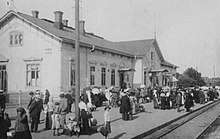
After the World War II, the city's population grew significantly, due in part to the settlement of Karelian evacuees and the high birth rate. The rapid growth of the population forced the expansion of schools; at the end of the 1940s, support was also provided for school transports[20] and the provision of free school meals (the poor people had received it in Kuopio since 1902[21]). The large number of young people and the occasional lack of activity also gave rise to various phenomena in the city, such as the Kuopio Market Riot in 1965.[22][23] In the 1960s, the first construction of the actual suburb, Puijonlaakso, began. Since then, the new areas have each grown in turn: in the 1960s, Puijonlaakso and Tiihotar (as part of Saarijärvi); In the 1970s Saarijärvi, Kelloniemi and Levänen; In the 1980s, Jynkkä and Neulamäki.
The municipality of Maaninka joined the city of Kuopio in 2015, the town of Nilsiä in 2013, and Karttula[24] in 2011, as did Vehmersalmi in 2005, Riistavesi in 1973, and Kuopion maalaiskunta in 1969.[19]
Geography
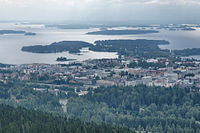

The city is surrounded by Lake Kallavesi, and several parts of it are built on islands. Kuopio's ample waterfronts and islands are also used in the Saaristokaupunki (lit. Archipelago city) -project, the biggest residential area currently being built in Finland.[25] Saaristokaupunki will accommodate a total of 14,000 inhabitants in 2015. All houses will be situated no more than 500 metres (1,600 ft) from the nearest lakeshore.[26]
Kuopio Market Square is the undisputed center of the city and the city center follows a densely built grid pattern with several parks and narrow gutter streets.[27] The environment of the city is quite distinctive; the surface shapes of the waterfront-lined center are so variable that a flat property is a desired rarity.[28] The settlement has spread outside the center of Kuopio according to a dense and sparse finger model that is affordable for public transport,[29] and the new districts have been built in a municipal drive at once; for example, the Saaristokaupunki was banned for building for the previous 25 years,[30] and this Kuopio zoning tradition has a long history.[30] Due to the above-mentioned factors, the population density of the Kuopio city center is the highest in Finland.[31]
With the surrounding lakes, the shoreline in Kuopio is 4,760 kilometers.[32] Of the Finnish municipalities, Kuopio has the second largest number of summer cottages and holiday homes. In 2013, the number of summer cottages was 8,684. The number of summer homes in Kuopio has increased in recent years due to municipal associations.[33]
Climate
Kuopio falls in the subarctic climate zone (Köppen "Dfc"), closely bordering on continental due to its warm summers. Winters are long and cold, with average highs staying below freezing from November until March, and summers are short and relatively mild. Most precipitation occurs in the late summer and early fall. The summers are relatively warm for its latitude, especially the lows. This is due to influence from the lake, making it much warmer on summer nights than in areas away from water. In winter, maritime moderation is eliminated as the lake freezes over.
| Climate data for Kuopio Airport (1981-2010 normals, extremes 1940-present) | |||||||||||||
|---|---|---|---|---|---|---|---|---|---|---|---|---|---|
| Month | Jan | Feb | Mar | Apr | May | Jun | Jul | Aug | Sep | Oct | Nov | Dec | Year |
| Record high °C (°F) | 7.9 (46.2) |
9.2 (48.6) |
13.3 (55.9) |
21.9 (71.4) |
28.6 (83.5) |
31.1 (88.0) |
33.8 (92.8) |
33.2 (91.8) |
25.8 (78.4) |
16.0 (60.8) |
11.1 (52.0) |
8.6 (47.5) |
33.8 (92.8) |
| Average high °C (°F) | −6.0 (21.2) |
−5.7 (21.7) |
−0.2 (31.6) |
6.4 (43.5) |
14.1 (57.4) |
18.9 (66.0) |
21.8 (71.2) |
18.9 (66.0) |
13.0 (55.4) |
6.3 (43.3) |
−0.1 (31.8) |
−3.9 (25.0) |
7.0 (44.5) |
| Daily mean °C (°F) | −9.2 (15.4) |
−9.2 (15.4) |
−4.1 (24.6) |
2.0 (35.6) |
9.1 (48.4) |
14.5 (58.1) |
17.5 (63.5) |
15.0 (59.0) |
9.7 (49.5) |
4.1 (39.4) |
−2.0 (28.4) |
−6.7 (19.9) |
3.4 (38.1) |
| Average low °C (°F) | −12.6 (9.3) |
−13.0 (8.6) |
−8.0 (17.6) |
−2.2 (28.0) |
4.3 (39.7) |
10.3 (50.5) |
13.6 (56.5) |
11.7 (53.1) |
7.0 (44.6) |
2.1 (35.8) |
−4.1 (24.6) |
−9.7 (14.5) |
−0.1 (31.9) |
| Record low °C (°F) | −39.3 (−38.7) |
−37.0 (−34.6) |
−33.0 (−27.4) |
−20.9 (−5.6) |
−8.2 (17.2) |
0.1 (32.2) |
4.7 (40.5) |
2.7 (36.9) |
−4.9 (23.2) |
−15.0 (5.0) |
−27.6 (−17.7) |
−41.1 (−42.0) |
−41.1 (−42.0) |
| Average precipitation mm (inches) | 48 (1.9) |
36 (1.4) |
36 (1.4) |
30 (1.2) |
46 (1.8) |
67 (2.6) |
80 (3.1) |
75 (3.0) |
53 (2.1) |
56 (2.2) |
52 (2.0) |
51 (2.0) |
630 (24.7) |
| Average precipitation days | 11 | 9 | 9 | 7 | 9 | 10 | 11 | 11 | 10 | 11 | 11 | 11 | 120 |
| Source: Finnish Meteorological Institute[34] | |||||||||||||
| Kuopio | ||||||||||||||||||||||||||||||||||||||||||||||||||||||||||||
|---|---|---|---|---|---|---|---|---|---|---|---|---|---|---|---|---|---|---|---|---|---|---|---|---|---|---|---|---|---|---|---|---|---|---|---|---|---|---|---|---|---|---|---|---|---|---|---|---|---|---|---|---|---|---|---|---|---|---|---|---|
| Climate chart (explanation) | ||||||||||||||||||||||||||||||||||||||||||||||||||||||||||||
| ||||||||||||||||||||||||||||||||||||||||||||||||||||||||||||
| ||||||||||||||||||||||||||||||||||||||||||||||||||||||||||||
Transport

The city has a nationally unique feature in its street network, where every other street is reserved for pedestrian and cycle traffic,[36] so-called "rännikatu" (derived from the Swedish gränd, alley). These streets provide pedestrians a calm environment away from vehicular traffic.[37] This setup dates back to Kuopio's first town plan by Pehr Kjellman in 1776. Originally, rännikadut were created as a fire barrier to prevent a possible fire escalating in a mainly wood-constructed city.[38]
Two Finnish highways cross Kuopio: Finnish national road 5 (Vt 5), which extends south to Helsinki and north to Sodankylä, and Finnish national road 9 (Vt 9), which extends west to Turku and east to the Niirala checkpoint on the Finnish-Russian border. The Blue Highway passes through Kuopio. It is an international tourist route from Mo i Rana, Norway to Pudozh, Russia via Sweden and Finland.
Long-distance transport connections from Kuopio include Pendolino and InterCity trains from Kuopio railway station to several destinations around Finland, operated by VR, as well as multiple daily departures from Kuopio Airport on Finnair to Helsinki.
Education and business

| University | Students |
|---|---|
| University of Eastern Finland | 6 229[39] |
| Savonia University of Applied Sciences | 5 000[40] |
| HUMAK University of Applied Sciences | ~150 |
| Sibelius Academy | ~100 |
Kuopio has always been a city of education. Some of the first schools offering education in Finnish (such as the School for the Blind in 1871, and the Trade School in 1887) were established in Kuopio. Currently the most important institutions are the University of Eastern Finland, the Savonia University of Applied Sciences, Vocational College of Northern Savonia and the Kuopio department of the Sibelius Academy. One of the oldest schools in the city are Kuopio Lyceum High School, which was officially established in 1872, but was originally built in 1826 and designed by Carl Ludvig Engel.
Kuopio is known as a strong center of health (e.g. it has the biggest yearly enrollment rate of medical students in Finland), pharmacy, environment, food & nutrition (all legalized Clinical and Public Health Nutritionists in Finland graduate from the University of Eastern Finland), safety (education in Emergency Services is centered in Kuopio[41]) and welfare professions, as the major organisations University of Kuopio (now part of the University of Eastern Finland since January 2010.[42]), Savonia University of Applied Sciences and Technopolis Kuopio are particularly oriented to those areas.
There are about 4,200 enterprises in Kuopio,[43] of which approximately 180 are export companies.[44] These provide about 45,000 jobs.[44]
People and culture

Kuopio is known as the cultural center of Eastern Finland. One of the Kuopio's most important cultural venues are the Kuopio Museum and the Kuopio City Theatre in the city center. A wide range of musical (from kindergarten to doctorate-level studies) and dance education is available and the cultural life is active. Notable events include ANTI – Contemporary Art Festival, Kuopio Dance Festival, Kuopio Rockcock, Kuopio Wine Festival, Kuopio Marathon and Finland Ice Marathon in winter. A notable place, however, to enjoy the local flavor of Kuopio life and food is Sampo, a fish restaurant loved by locals and tourists as well. The city has a comprehensive hotel offer for tourism, one of the most notable is Hotel Savonia, part of the Best Western hotel chain.
Kuopio is known for its association with a national delicacy, Finnish fish pastry (Kalakukko), and the dialect of Savo, as well as the hill of Puijo and the Puijo tower. Besides being a very popular outdoor recreation area, Puijo serves also as a stage for a yearly World Cup ski jumping competition.
In inhabitants of Kuopio have a special reputation: they are known as jovial and verbally joking. Within the Savo culture, the onus is placed on the listener to interpret the story. People of the Kuopio region and Eastern Finland have always had many health problems and the mortality has been higher than on an average in Finland. Because of this, Eastern Finland has been a hotspot for Public Health studies. The North Karelia Project by the University of Kuopio in coordination with the National Public Health Institute and the World Health Organization, beginning in the 1970s was one of its first steps towards world class research.
During the 2000s, Kuopio has placed very well in a number of image, popularity and city-attractiveness surveys. In 2007 it was placed third, behind Tampere and Oulu.
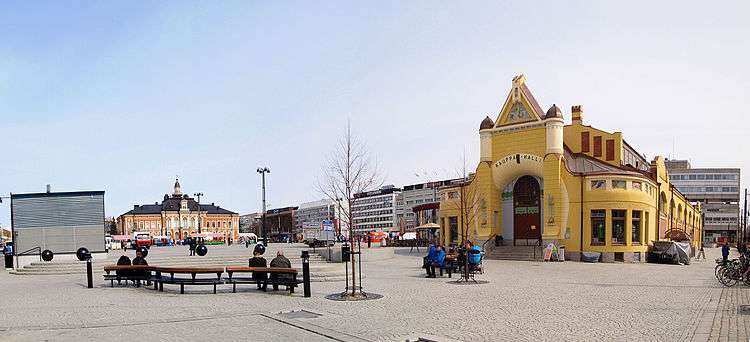
Religion

The largest church denomination in Finland, Evangelical Lutheran Church has a diocese in Kuopio, which is shepherded by bishop Jari Jolkkonen.[45]
Kuopio is home of the Finnish Orthodox Church where its primate, archbishop of Karelia and all Finland Leo (Makkonen) is seated. This is an autonomous jurisdiction affiliated with the Patriarchate of Constantinople. It is the only mainstream Orthodox faction to celebrate Easter on the Latin date. The late Archbishop Paul had been successful in producing literature of popular theology. The city is also the location of RIISA- Orthodox Church Museum of Finland.
Kuopio also has an Islamic mosque.[46] Muslims from various parts of the world and certain Finnish Muslims live in Kuopio.
The town is also home to the first Burmese Buddhist monastery in Finland, named the Buddha Dhamma Ramsi monastery.[47]
Notable people
- Livo Niskanen
- Juhani Aho
- Martti Ahtisaari
- Kasperi Kapanen
- Minna Canth
- Pekka Halonen
- Janne Happonen
- Matti Hautamäki
- Marco Hietala
- Zachary Hietala
- Janne Tolsa
- Olli Jokinen
- Kasperi Kapanen
- Sami Kapanen
- Elina Karjalainen
- Mika Kojonkoski
- H. Olliver Twisted
- Hannes Kolehmainen
- Lasse Lehtinen
- Paavo Lipponen
- Archbishop Leo
- Martti Nissinen
- Petri Partanen
- Pertti "Spede" Pasanen
- Aarno Ruusuvuori
- Aulis Rytkönen
- Tuomo Saikkonen
- Sanna Sillanpää
- Alma (Finnish singer)
- Johan Vilhelm Snellman
- Kimmo Timonen
- Jenni Vartiainen
- Paavo Lötjönen
- Päivi Setälä
- Brothers von Wright: Magnus, Wilhelm and Ferdinand
Sports in Kuopio
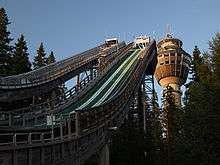
Kuopio bid for the 2012 Winter Youth Olympics, a youth sports festival in the tradition of the Olympics. It became a finalist in November 2008, but ultimately lost to Innsbruck, Austria. Kuopio's image as a small city with a large University and many active young people was considered a model of what the International Olympic Committee seeks for the Games.[48]
- KalPa (ice hockey)
- KuPS (football)
- Kuopion Taitoluistelijat (figure skating)
- Puijon Hiihtoseura (skiing, ski jumping, nordic combined, biathlon)
- Puijon Pesis (pesäpallo)
- Kuopion Reippaan voimistelijat (gymnastics)
- Finland Ice Marathon (ice skating event)
- Kuopio Steelers (american football)
- Kuopio Skating club, Kuopion Luisteluseura KuLs (figure skating)
- Welhot (floorball)
- Linkki (basketball)
International relations
Kuopio is twinned with 15 cities around the world. It also has one twin county, Lääne-Viru County, Estonia.[49]
References
- Notes
- "Area of Finnish Municipalities 1.1.2018" (PDF). National Land Survey of Finland. Retrieved 30 January 2018.
- "Suomen virallinen tilasto (SVT): Väestön ennakkotilasto [verkkojulkaisu]. Tammikuu 2019" (in Finnish). Statistics Finland. Retrieved 15 March 2019.
- "Population according to language and the number of foreigners and land area km2 by area as of 31 December 2008". Statistics Finland's PX-Web databases. Statistics Finland. Retrieved 29 March 2009.
- "Population according to age and gender by area as of 31 December 2008". Statistics Finland's PX-Web databases. Statistics Finland. Retrieved 28 April 2009.
- "List of municipal and parish tax rates in 2011". Tax Administration of Finland. 29 November 2010. Retrieved 13 March 2011.
- YLE: Kuopio meni Helsingin ohi vetovoimaisuudessa – kaupunginjohtaja: "Pitkäjänteinen työ näkyy" (in Finnish)
- "Taajamissa asuu 84 prosenttia väestöstä" (in Finnish). Statistics Finland. 15 January 2008. Retrieved 7 January 2009.
Tiheimmin asuttu oli Helsingin keskustaajama, jossa oli 1 690 asukasta maaneliökilometrillä. Seuraavaksi tiheimmin asuttuja olivat Kuopion keskustaajama (1 618 as./maa-km2)
- Hypo: Tässä ovat Suomen 10 kasvukeskusta (in Finnish)
- HS: Kuopio onnistui nousemaan Itä-Suomen aluekeskukseksi (in Finnish)
- Tällainen on Kuopio kymmenen vuoden kuluttua (in Finnish)
- "Finavia's Air Traffic Statistics 2010" (PDF). Vantaa: Finavia. pp. 7, 9. Archived from the original (PDF) on 24 January 2012. Retrieved 15 July 2011.
- Kuntarating 2017 (in Finnish)
- Tutkimus: Asintosijoittajan paras kaupunki on nyt Kuopio – Varoitus kiinnostuksen lopahtamisesta (in Finnish)
- Taloustutkimus: Seinäjoella on paras imago (in Finnish)
- "European region of gastronomy Kuopio 2020". Taste Savo. Retrieved 15 July 2020.
- Kuopio - muutakin kuin kalakukkoa (English subtitled)
- The Rough Guide to Finland. Rough Guides, 2010. ISBN 1848362579
- Archived 26 January 2010 at the Wayback Machine
- "History and basic data". Kuopio in Brief. City of Kuopio. Archived from the original on 4 November 2016. Retrieved 2 November 2016.
- Kaupungin elämää 1947 (in Finnish)
- 1872 Koulun arkea: Rangaistukset (in Finnish)
- YLE: Torimellakka Kuopiossa 1965 (in Finnish)
- Erikoislehti kertoo: Miksi nuoriso riehui Kuopion torilla? - Savon Sanomat (in Finnish)
- "Karttula sulautuu Kuopioon" & "Karttula ja Kuopio yhteen". Myöhänen, Pentti & Manner, Matias & Hartikainen, Jarno; Savon Sanomat. 1 July 2008. pp. 1 and 3.
- "Kuopion korkein asuinkerrostalo nousi harjakorkeuteen". Suomen Kiinteistölehti. 16 October 2008. p. 14. Archived from the original on 24 February 2009.
- "Kallaveden syleilyssä". Saaristokaupunki. Kuopio. Archived from the original on 29 January 2009. Retrieved 7 January 2009.
- Kuopion rännikaduista tehdään nykyaikaa mennyttä kunnioittaen (in Finnish)
- Kuopion kaupungin tekninen virasto: Kuopio 2009 suunnittelee ja rakentaa (2009)
- Kuopion Saaristokaupunki – kasvusuuntana täydennysrakentaminen (in Finnish)
- Saaristokaupungista tulee viiden sillan ja 14 000 asukkaan alue – Kuopio laajenee (in Finnish)
- Leo Kosonen: Kuopio 2015: Jalankulku-, joukkoliikenne- ja autokaupunki. Ympäristöministeriö, 2007. ISBN 978-952-11-2852-3
- Esittely, Kaupunkitietoa - Kuopio.fi (in Finnish)
- Asuminen, Kaupunkitietoa - Kuopio.fi (in Finnish)
- "Tilastoja Suomen ilmastosta 1981 - 2010". Finnish Meteorological Institute.
- WP2: Accessibility, Synthesis Report (PDF). Universell utforming. 26 March 2004. p. 14.
- Description of the Case Areas (PDF). VTT Technical Research Centre of Finland. 2 May 2002. p. 8.
- "Napoleon ja Kuopio: Kuninkaiden Kuopio". Memory of Northern Savonia. Museums of Northern Savonia. Archived from the original on 25 February 2009. Retrieved 11 January 2009.
- "Key Data for 2007". University of Kuopio. 2007. Archived from the original on 25 January 2009. Retrieved 9 January 2009.
- "In English". Savonia University of Applied Sciences. 2009. Archived from the original on 4 January 2011. Retrieved 9 January 2009.
- Emergency Services College
- Steps leading to the establishment of the UEF Archived 27 February 2013 at the Wayback Machine
- Kuopion työpaikat ja elinkeinorakenne 1.1.2008 (PDF). Kuopion kaupungin yrityspalvelu. 2008. pp. 1–2. Archived from the original (PDF) on 7 December 2010. Retrieved 9 January 2009.
- "Elinkeinoelämä". City of Kuopio. 7 October 2008. Archived from the original on 26 February 2009. Retrieved 9 January 2009.
- Koskinen, Jerri (6 May 2012). "Jari Jolkkonen vihittiin Kuopion piispan virkaan". Savon Sanomat. Retrieved 11 May 2012.
- "Kuopio Mosque".
- "Buddhist Channel | Buddhism News, Headlines | World | Burmese Buddhist monastery opens in Finland". Buddhistchannel.tv. 5 January 2009. Retrieved 16 September 2011.
- Innsbruck and Kuopio Make Final Shortlist For 2012 Youth Olympic Winter Games Archived 8 January 2012 at the Wayback Machine
- "Twin cities". City of Kuopio. Retrieved 21 August 2019.
External links
| Wikimedia Commons has media related to Kuopio. |
| Wikivoyage has a travel guide for Kuopio. |
- Kuopio – Official website (in Finnish, Swedish, English, German, French, Spanish, and Russian)
- City of Kuopio – Another official website (in Finnish, Swedish, English, and German)
- KuopioInfo – Various resources about different areas of interest related to Kuopio History and Life (in Finnish, English, German, Russian, and Chinese)
- 360° panorama of Kuopio Marketplace
- Savonia University of Applied Sciences (in English)
- University of Eastern Finland (in English)
- Technopolis Kuopio (in Finnish, English, and Russian)
- Invest in Kuopio -factsheet (in English)
- Kuopio Mosque
- Satellite picture by Google Maps
